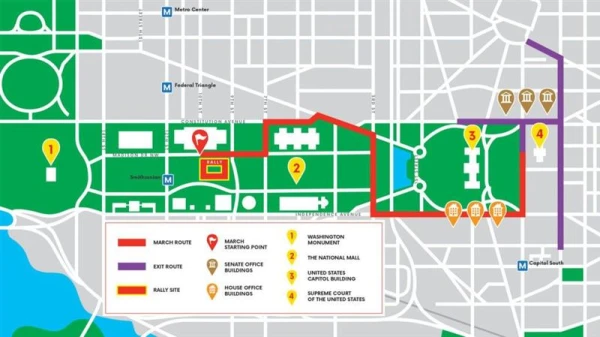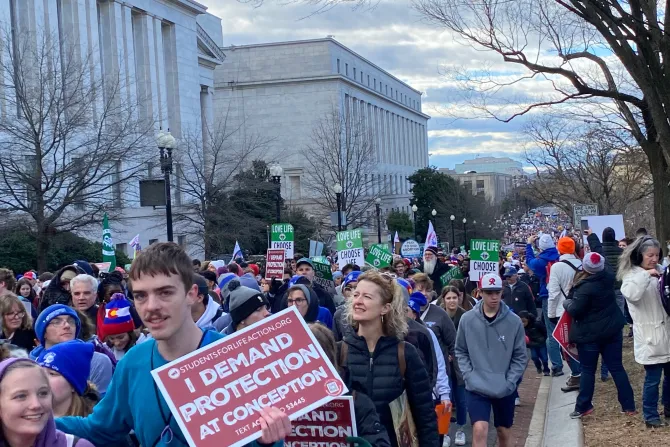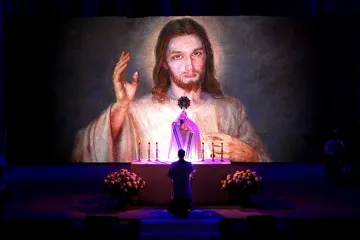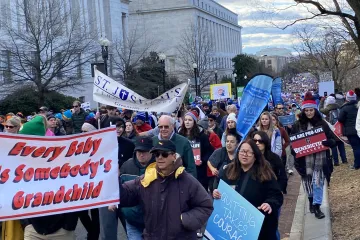Washington, D.C. Newsroom, Jan 17, 2024 / 11:42 am
The 51st national March for Life — the largest annual pro-life event in the world — is just around the corner, on Friday, Jan. 19.
The 2024 march, the second since the overturn of Roe v. Wade, follows a year of several difficult legislative losses for the pro-life movement. The organizers of the March for Life are, however, taking a joyful, hopeful outlook. The march’s theme, “With Every Woman, for Every Child,” celebrates the work of pregnancy resource centers across the country.
Here’s what to know about the 2024 March for Life.
What is the March for Life?
One of the largest annual human rights demonstrations in the world, every year the March for Life gathers tens of thousands to hundreds of thousands of pro-lifers from across the country for a day of prayer and peaceful witness.
Begun in 1974 in response to the Supreme Court’s 1973 Roe v. Wade decision that legalized abortion nationwide, today the March for Life is the premier pro-life event in the country. The march gathers large crowds of pro-lifers in the nation’s capital on or around Roe’s anniversary. Always notable are the large numbers of young adults and students at the March for Life.
These pro-life Americans gather not only to end abortion but also to celebrate the beauty of life, beginning from the moment of conception.
What will the weather be like?
The National Weather Service is currently forecasting snow beginning Thursday evening and continuing — possibly mixing with rain — until 1 p.m. Friday. Temperatures won’t top 34 degrees. The chance of precipitation is 80%.
With Roe gone, what are pro-lifers marching for?
Since the overturn of Roe v. Wade in June 2022, the March for Life has made it clear that it will continue marching for the unborn.
The March for Life website says that “even with the wonderful blessing of Roe v. Wade being overturned, which allows more freedom at the state level to enact pro-life laws, the necessary work to build a culture of life in the United States of America is not finished.”
Despite the end of Roe, the March for Life organizers point out that there are still over 900,000 American babies killed by abortion every year. Additionally, since 2022 several states such as Ohio, Michigan, and Kansas passed constitutional amendments that go beyond the scope of Roe to enshrine unrestricted abortion into the state constitutions. Now, several more states are considering passing new abortion laws that present an even greater threat to unborn life than under Roe.
“The goal of the national March for Life is to not only change laws at the state and federal level but to change the culture to ultimately make abortion unthinkable,” the March for Life website says. “We will continue to march every January at the national level until a culture of life is restored in the United States of America.”
What does the theme mean?
According to the March for Life website, the theme “With Every Woman, for Every Child” calls attention to the need to care for both mother and child during and after pregnancy. The theme also celebrates the work of pregnancy care centers and maternity homes that help mothers, children, and families across the nation.
(Story continues below)
Check out the official march theme video here:
What’s on the schedule?
The March for Life will begin at 1 p.m. on Friday.
Additionally, there are several official events taking place before and after the march.
9–11 a.m.
March for Life Expo at Westin D.C. Downtown Hotel, Rock Creek Ballroom
11 a.m.–noon
Pre-rally concert on National Mall
Noon–1 p.m.
March for Life Rally on National Mall
1–4 p.m.
March for Life, beginning at the National Mall and ending in front of the Supreme Court building
4–5 p.m.
March for Life Expo at Westin D.C. Downtown Hotel, Rock Creek Ballroom
6–9 p.m.
Rose Dinner Gala
What other pro-life events are taking place in D.C.?
Several other pro-life events related to the march will also take place on Thursday and Friday.
National Prayer Vigil for Life:
Thursday, Jan. 18, beginning at 5 p.m.
The Basilica of the National Shrine of the Immaculate Conception
The United States Conference of Catholic Bishops will hold a national prayer vigil beginning the night before the march and extending until the morning of. The vigil will consist of Mass celebrated by Arlington, Virginia, Bishop Michael Burbidge, head of the USCCB’s Pro-Life Activities Committee; a Holy Hour for life; and another Mass celebrated by Columbus, Ohio, Bishop Earl Fernandes on Friday morning.
Click here for more info on the prayer vigil.
Life Fest:
Friday, Jan. 19, 6–11 a.m.
The D.C. Armory
Hosted by the Sisters of Life and the Knights of Columbus, Life Fest is an upbeat, youth-oriented pre-march event that includes musical performances, inspirational speakers, Mass, and praise and worship adoration.
Click here for more info on Life Fest.
More related events can be found on the March for Life’s website here.
Who are the speakers?
This year the March for Life Rally will feature several notable pro-lifers including former NFL tight end Benjamin Watson, Speaker of the House Mike Johnson, and Focus on the Family President Jim Daly as well as a musical performance by Christian artist Danny Gokey.
Click here to see a full list of speakers.
Where do I go to attend the march?
The March for Life will begin at the rally site on the National Mall lawn between the U.S. Capitol building and the Washington Monument.
Here is a map of the march route, noting the starting point:

What’s the best way to get around D.C. on Friday?
March for Life organizers say that the easiest way to get around on the day of the march is via the Washington, D.C., Metro system. There are three Metro stops within easy walking distance from the rally point, according to the March for Life.
These Metro stations are Federal Triangle, Smithsonian, and Metro Center.
Metro users will have to purchase a Metro “SmartTrip” pass to access the rail system. Passes are available for purchase at every Metro station.






